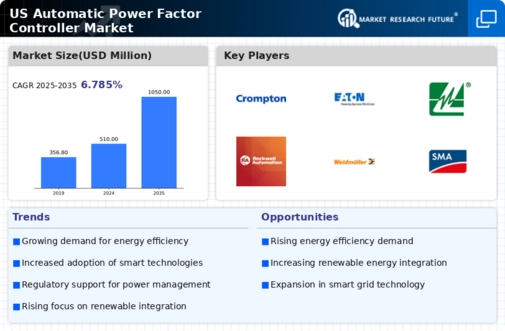Rising Energy Costs
Rising energy costs in the United States significantly influence the automatic power-factor-controller market. As energy prices continue to rise, businesses are increasingly seeking solutions to reduce their energy consumption and costs. Automatic power-factor controllers play a crucial role in this regard by improving the power factor and reducing energy waste. In 2025, companies could save up to 15% on their energy bills by implementing these controllers. This financial incentive drives the adoption of automatic power-factor controllers across various sectors, including manufacturing and commercial buildings, thereby propelling market growth. The focus on cost reduction is expected to remain a primary motivator for businesses in the coming years.
Growing Industrial Automation
The increasing trend towards industrial automation in the United States is a key driver for the automatic power-factor-controller market. As industries adopt advanced technologies to enhance productivity, the need for efficient power management becomes paramount. Automatic power-factor controllers help in optimizing energy consumption, thereby reducing operational costs. In 2025, the industrial sector is projected to account for approximately 30% of the total demand for these controllers. This shift towards automation not only improves efficiency but also aligns with sustainability goals, as companies seek to minimize their carbon footprint. Consequently, The automatic power-factor-controller market is likely to experience substantial growth as industries invest in these technologies.
Increased Focus on Sustainability
The emphasis on sustainability and environmental responsibility significantly drives the automatic power-factor-controller market. In the United States, businesses are under pressure to reduce their carbon emissions and improve energy efficiency. Automatic power-factor controllers contribute to these goals by optimizing energy usage and minimizing waste. In 2025, it is anticipated that companies prioritizing sustainability will account for a substantial portion of the market demand. This trend is further supported by consumer preferences for environmentally friendly practices, prompting organizations to invest in technologies that align with sustainability objectives. As a result, the automatic power-factor-controller market is poised for growth as more companies adopt these solutions.
Regulatory Compliance Requirements
Regulatory compliance requirements are increasingly shaping the landscape of the automatic power-factor-controller market. In the United States, various regulations mandate energy efficiency standards for industrial and commercial facilities. These regulations often require the implementation of technologies that enhance power factor and reduce energy consumption. As businesses strive to meet these compliance standards, the demand for automatic power-factor controllers is expected to rise. In 2025, it is projected that compliance-related investments will drive a significant portion of the market growth. This regulatory environment not only encourages the adoption of automatic power-factor controllers but also fosters innovation in the development of more efficient power management solutions.
Technological Advancements in Power Management
Technological advancements in power management systems are fostering growth in the automatic power-factor-controller market. Innovations such as IoT integration and real-time monitoring capabilities are enhancing the functionality of these controllers. In 2025, the market is expected to witness a surge in demand for smart power-factor controllers that can provide detailed analytics and automated adjustments. This evolution not only improves energy efficiency but also allows for better compliance with regulatory standards. As industries increasingly adopt these advanced technologies, the automatic power-factor-controller market is likely to expand, driven by the need for sophisticated energy management solutions.






















Leave a Comment